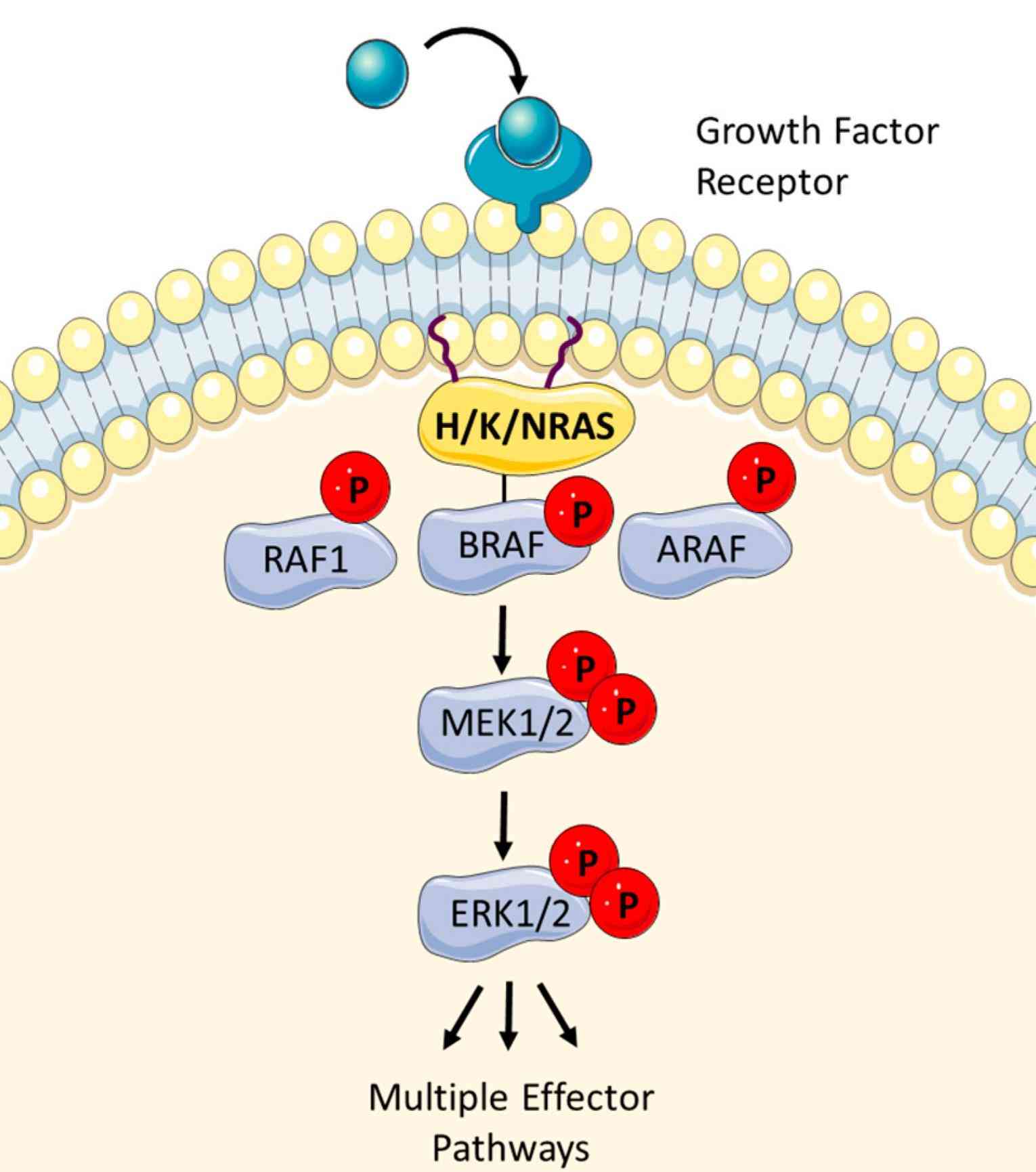What is RAF1 Protein
The official full name of the RAF1 protein is "Raf-1 proto-oncogene, serine/threonine kinase," and it is also known by several synonyms, including c-Raf, Raf-1, and RAF proto-oncogene serine/threonine-protein kinase. RAF1 belongs to the protein kinase family and plays a critical role in transmitting signals within the cell. It is a pivotal member of the RAF kinase family, along with ARAF and BRAF, which collectively regulate cell growth and differentiation.
RAF1 Protein Structural Characteristics and Classification
RAF1 is a 648 amino acid protein that features several distinct structural domains. The N-terminal region contains a Ras-binding domain, followed by a CR1 regulatory domain and a kinase domain. The C-terminal region of RAF1 contains a regulatory region that plays a crucial role in regulating the protein's activity. This C-terminal region contains the 14-3-3 binding site, which interacts with 14-3-3 proteins and modulates RAF1's activity.
Recent Research Advances about RAF1 Protein
Recent research has shed light on RAF1's significance in cellular signaling. Studies have revealed that mutations in the RAF1 gene can lead to various diseases, including Noonan syndrome, a genetic disorder that affects multiple systems of the body. Additionally, research has uncovered the complex regulatory mechanisms that control RAF1's activity, including phosphorylation events that can either activate or inhibit the protein. Understanding these mechanisms has paved the way for targeted therapies in diseases driven by RAF1 mutations.
RAF1 Biological Functions and Molecular Mechanisms
RAF1 plays a pivotal role in cellular signaling and serves as a key component of the MAPK (Mitogen-Activated Protein Kinase) signaling pathway. This pathway is involved in transmitting extracellular signals to the cell nucleus, where they regulate various cellular processes. RAF1 is a serine/threonine kinase, meaning it phosphorylates target proteins on serine or threonine residues, ultimately influencing their activity.
The primary function of RAF1 is to transmit signals from cell surface receptors to downstream effectors. When an extracellular ligand binds to a receptor, a cascade of events is triggered, leading to the activation of RAF1. RAF1, in turn, activates the downstream kinase MEK1/2, which subsequently phosphorylates and activates ERK1/2. This activated ERK1/2 then enters the nucleus to modulate gene expression, thereby regulating processes like cell growth, differentiation, and proliferation.
RAF1 Related Signaling Pathway
The RAF1 protein is a central player in the MAPK signaling pathway, which is crucial for transmitting extracellular signals to the nucleus. The pathway involves a series of protein kinases, including RAF1, MEK1/2, and ERK1/2. Activation of this pathway regulates cell growth, proliferation, and differentiation, and its dysregulation is linked to various diseases, including cancer.
The MAPK pathway is initiated when growth factors or other ligands bind to cell surface receptors, leading to the activation of RAF1. RAF1 then phosphorylates and activates MEK1/2, which, in turn, phosphorylates and activates ERK1/2. Activated ERK1/2 translocates to the nucleus and influences gene expression, thereby regulating cellular responses to extracellular signals.

Figure 1. The RAF-MEK-ERK pathway is activated by H/K and NRAS upon extracellular stimuli. (Nolan A A, et al., 2021)
RAF1 Related Diseases
- Noonan Syndrome: Mutations in the RAF1 gene have been linked to Noonan syndrome, a genetic disorder characterized by a wide range of developmental and medical problems. These mutations can lead to abnormal activation of the RAF1 protein, resulting in uncontrolled cell growth and altered developmental pathways.
- Cancer: Dysregulation of the RAF1 gene has been associated with various types of cancer, particularly melanoma and colorectal cancer. Mutations in RAF1 can lead to uncontrolled cell division and contribute to tumorigenesis.
RAF1's Applications in Biomedicine
- Diagnostic Development: Understanding RAF1's role in various diseases, especially cancer, has led to the development of diagnostic assays. By detecting mutations or dysregulation in the RAF1 gene or protein, clinicians can identify patients at risk of developing diseases like melanoma or Noonan syndrome.
- Vaccine Development: The MAPK pathway, in which RAF1 plays a key role, has been explored as a target for cancer vaccines. By developing vaccines that stimulate the immune system to recognize and attack cells with aberrant MAPK signaling, researchers aim to treat and prevent cancer.
- Therapeutics: Targeted therapies have been developed to inhibit the aberrant activity of RAF1 in diseases like cancer. Drugs known as RAF inhibitors have shown promise in treating melanoma, particularly in patients with BRAF-mutated tumors. These therapies work by blocking the activity of RAF proteins, thereby reducing cell proliferation and tumor growth.
Recommended Products
| Cat.# | Product name | Species | Source (Host) | Tag |
|---|---|---|---|---|
| RAF1-2161H | Recombinant Human RAF1, GST-tagged | Human | E.coli | GST |
| RAF1-1123H | Recombinant Human RAF1 Protein, GST-tagged | Human | E.coli | GST |
| RAF1-16H | Active Recombinant Human RAF1, GST-tagged | Human | Sf9 Insect Cell | GST |
| RAF1-416H | Active Recombinant Human RAF1 protein, GST-tagged | Human | Insect Cell | GST |
| RAF1-305H | Recombinant Human RAF1 | Human | Mammalian Cell | His |
| RAF1-553H | Recombinant Human RAF1, GST-tagged | Human | Wheat Germ | GST |
| RAF1-551H | Active Recombinant Human RAF1, GST-tagged | Human | Sf9 Insect Cell | GST |
| RAF1-552H | Recombinant Human RAF1, MYC/DDK-tagged | Human | HEK293 | Myc/DDK |
| RAF1-1122H | Recombinant Human V-raf-1 Murine Leukemia Viral Oncogene Homolog 1 | Human | E.coli | N/A |
| RAF1-352H | Recombinant Human RAF1 protein, His/MBP-tagged | Human | E.coli | His/MBP |
Reference
- Nolan A A, et al. Hidden targets in RAF signalling pathways to block oncogenic RAS signalling. Genes. 2021, 12(4): 553.

